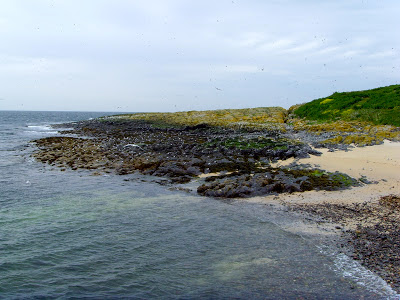 |
| The north end of Rudyard Lake (viewed from the west). Photo by Adam Archer |
The largest species of tern in the World has given me a right old run around in Britain over the years. Before finally connecting with one in Northamptonshire a decade ago this species had been the bane of my twitching life. I had dipped several and some individual birds on more than one occasion. To make matters even more frustrating the two sightings I have had in Britain had a combined viewing time of around one minute.
So with news of a CASPIAN TERN being found in my neighbouring County of Staffordshire yesterday I was eager to pull out all the stops to see it as soon as possible, despite suffering with a recently acquired hernia. Luckily Nadia was on hand to drive me up north this morning and following an early morning tip off by fellow Warwickshire bear Steve Seal we were on our way.
 |
| CASPIAN TERN (first summer) - Rudyard Lake, Staffordshire. Photo by Adam Archer |
Due to a satellite navigational glitch we ended up on the opposite site of Rudyard Lake to the crowd of birders on the eastern shore. This involved a pretty lengthy stroll in the early morning sunshine towards the northern area of the reservoir but in the end this turned out to be a stroke of luck. Upon arrival the orange-billed brute was showing very well indeed as we viewed it from the shelter of the lakeside trees. The bird spent the majority of its time loafing amongst the small number of gulls on the shell strewn mud but it would occasional fly off and exercise its wings over the water for a while before returning.
Other birds on site included at least 5 Oystercatcher, a flock of 63 Lapwing, 2 Little Ringed Plover, 3 Common Sandpiper and a first summer Common Gull. A Common Redstart was also heard calling. After studying the tern for a long while and attempting a few record shots with our iPhones we became more interested in watching the Carrion Crows attempting to break open some of the freshwater oysters, which the low water levels had exposed. It was great to see the look of concentration on the faces of the youngsters as they watched their parents carefully prise open the shells.
 |
| CASPIAN TERN (first summer) - Rudyard Lake, Staffordshire. Photo by Steve Seal |
The bird continued to entertain a steady stream of birders throughout the day at the northern end of the reservoir before flying off high to the north at 4.45pm. It was then relocated at its favoured roosting sight just a few miles north at Acre Nook Sand Quarry in Cheshire about a hour later. This is the site where it was originally located in the gull roost on the 24 July 2013.
 |
| CASPIAN TERN (first summer) - Rudyard Lake, Staffordshire. Photo by Steve Seal |
The CASPIAN TERN in Staffordshire
This is just the ninth sighting of this species in the County. The CASPIAN TERN has a cosmopolitan, highly scattered breeding distribution. It occurs on every continent with the exception of South America and Antarctica. Almost all of the north European population is centred in the coastal habitats of the Baltic Sea. This population is of conservation concern based in a drop of 2,200 breeding pairs in 1971 to 1,500 in 1999-2001. Other favoured breeding areas are in Finland, Sweden and Estonia in the north and sporadically in various Countries in south east Europe and Turkey. During the winter months they spend their time feeding around coastal West Africa south to the Gulf of Guinea but can also be found at large bodies of freshwater too.
All previous records of the species in Staffordshire are as follows:
2013 - Rudyard Lake - 26th to 28th July.
1999 - Westport Lake - 3rd June only.
1993 - Drayton Bassett Pits - 10th May only (brief visit from Dosthill Lake, Warwickshire).
1992 - Belvide Reservoir - 21st June only.
1988 - Westport Lake - 8th June only.
1984 - Rocester (recorded as Alton by British Birds) - 26th April only.
1973 - Cannock Chase Reservoir (now Chasewater) on 14th October only.
1972 - Blithfield Reservoir - 16th July only.
1968 - Belvide Reservoir - 20th July only.
Taking the West Midlands region as a whole there have also been four records from Warwickshire (1975, 1976, 1988 and 1993 as above), one from Worcestershire (1971) and another one from the West Midlands (1979).












